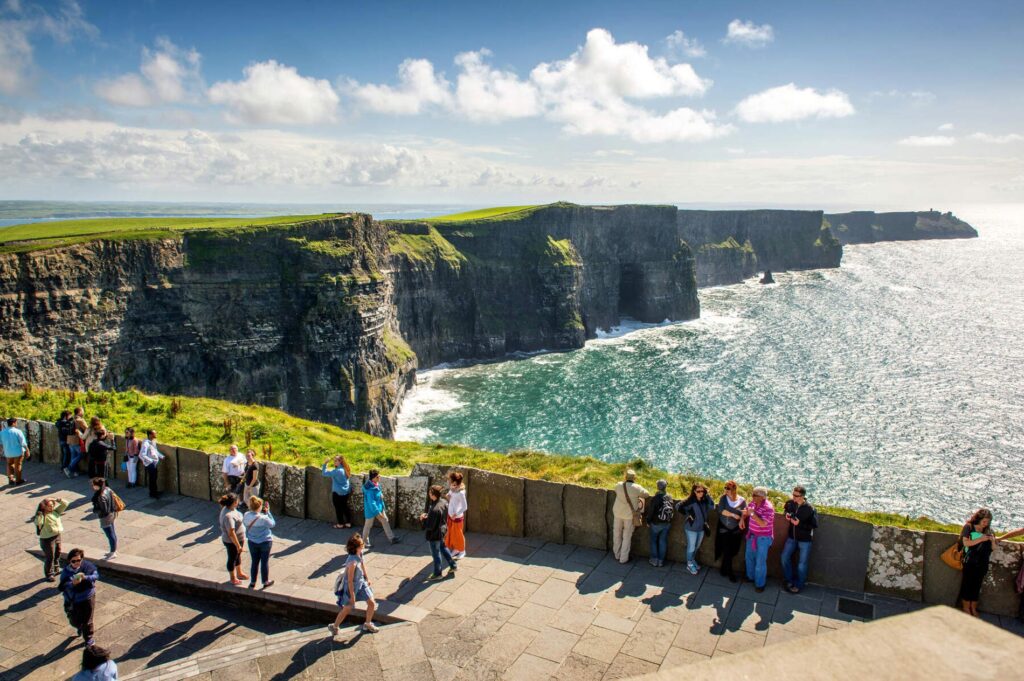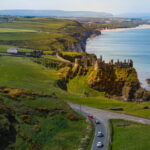Welcome to the enchanting world of the Cliffs of Moher. Standing tall and majestic on the rugged west coast of Ireland, these awe-inspiring cliffs have captivated visitors for centuries. As you approach, the sheer scale and grandeur of this natural wonder will take your breath away.
With our helpful tips for your visit, you’ll learn about the fascinating story behind the creation of the Cliffs of Moher and discover the best ways to experience their beauty.
The geological formation of the Cliffs of Moher
The Cliffs of Moher are the result of millions of years of geological processes. These majestic cliffs were formed during the Carboniferous period, approximately 320 million years ago. At that time, the region was submerged under a shallow tropical sea, and the accumulation of marine sediments led to the formation of limestone.
Over time, tectonic movements and erosion by wind and water shaped the limestone into the magnificent cliffs we see today. The layers of rock tell a story of ancient marine life, with fossils of corals, brachiopods, and crinoids embedded within them. The cliffs rise to a height of 214 meters (702 feet) at their highest point, offering breathtaking views of the Atlantic Ocean.
The cliffs are constantly changing due to the erosive power of the waves crashing against them. The relentless force of the Atlantic Ocean has created sea caves, arches, and stacks along the coastline, adding to the dramatic beauty of the cliffs.
Historical significance of the Cliffs of Moher
The Cliffs of Moher hold great historical and cultural significance for the people of Ireland. For centuries, they have been a symbol of Ireland’s rugged beauty and resilience. The cliffs have inspired countless artists, writers, and musicians, and have been featured in numerous works of literature and art.
In ancient times, the cliffs served as a natural defense against invaders, and several forts were built along their edges. These forts, such as the Moher Tower and the Hag’s Head, provided strategic vantage points for surveillance and defense. Today, visitors can explore the ruins of these forts and imagine the lives of the people who once inhabited them.
During the Great Famine in the 19th century, the cliffs witnessed scenes of despair as many Irish people emigrated in search of a better life. The cliffs became a poignant symbol of the hardships faced by the Irish people during that time.
Famous movies filmed at the Cliffs of Moher
The Cliffs of Moher have also served as a stunning backdrop for several famous movies. The breathtaking scenery and dramatic cliffs have attracted filmmakers from around the world. One of the most iconic scenes filmed at the cliffs is from the movie “Harry Potter and the Half-Blood Prince,” where Harry and Dumbledore stand on the cliffs overlooking the sea.
Another notable film that featured the Cliffs of Moher is “The Princess Bride.” The cliffs provided the perfect setting for the Cliffs of Insanity, where the protagonist, Westley, scales the cliffs to rescue Princess Buttercup.
The presence of the cliffs in these films has further enhanced their reputation as a must-visit destination for film enthusiasts and nature lovers alike.
Tips for visiting the Cliffs of Moher
Visiting the Cliffs of Moher can be an unforgettable experience, but it’s important to plan ahead to make the most of your trip. Here are some tips to ensure a smooth and enjoyable visit:
- Choose the best time to visit: The Cliffs of Moher are open year-round, but the best time to visit is during the spring and summer months when the weather is milder. The cliffs can get crowded during peak tourist season, so consider visiting early in the morning or late in the evening to avoid the crowds.
- Dress appropriately: The weather at the cliffs can be unpredictable, so it’s essential to dress in layers and wear sturdy footwear. Be prepared for strong winds and potential rain showers, even on sunny days.
- Take your time: The Cliffs of Moher are vast, so allocate enough time to explore them fully. Consider taking a guided tour or hiring a local guide who can provide valuable insights into the history and geology of the cliffs.
- Stay safe: The cliffs can be dangerous, especially near the edges. Follow the designated paths and barriers, and avoid getting too close to the edges. Be cautious of slippery areas, particularly after rainfall.
- Capture the moment: Don’t forget to bring your camera or smartphone to capture the breathtaking views. The cliffs offer endless photo opportunities, so take your time to find the perfect spot and angle for that Instagram-worthy shot.
Best time to visit the Cliffs of Moher
The Cliffs of Moher are a year-round destination, but the best time to visit depends on your preferences and the experience you’re seeking. If you prefer milder weather and smaller crowds, the spring and autumn months are ideal. The weather is generally pleasant, and you’ll have more space to explore and appreciate the cliffs’ beauty.
During the summer months, from June to August, the cliffs can get crowded with tourists. However, this is also when you’ll have the longest daylight hours, allowing for more time to enjoy the views and take leisurely walks along the cliffside paths.
If you’re a photography enthusiast or prefer dramatic weather conditions, winter can be a great time to visit. The cliffs are often shrouded in mist, creating an ethereal atmosphere. Just be prepared for colder temperatures and the possibility of strong winds.
Ultimately, the best time to visit the Cliffs of Moher is when it fits into your travel plans and aligns with your preferences for weather and crowds.
How to get to the Cliffs of Moher
The Cliffs of Moher are located on the west coast of Ireland, making them easily accessible from various parts of the country. Here are some common ways to reach the cliffs:
- By car: If you’re driving, the cliffs are approximately a 3-hour drive from Dublin and a 1.5-hour drive from Galway. Follow the signs for the Cliffs of Moher Visitor Experience, which has a dedicated parking area.
- By public transportation: Several bus companies offer tours from major cities such as Dublin and Galway. These tours typically include transportation to and from the cliffs, as well as a guided tour.
- By bike: For the more adventurous travelers, cycling to the cliffs can be a rewarding experience. There are several cycling routes that lead to the cliffs, allowing you to enjoy the scenic countryside along the way.
Once you arrive at the Cliffs of Moher, a visitor center provides information about the cliffs’ history, geology, and wildlife. From there, you can choose to explore the cliffs independently or join a guided tour for a more in-depth experience.
Attractions and activities near the Cliffs of Moher
While the Cliffs of Moher are undoubtedly the main attraction, the surrounding area has much more to offer. Here are some nearby attractions and activities to consider:
- The Burren: Located just south of the cliffs, the Burren is a unique landscape of limestone pavements, caves, and rare flora. Take a guided tour or hike through this fascinating karst region to discover its hidden treasures.
- Doolin: A charming village near the cliffs, Doolin is renowned for its traditional Irish music scene. Spend an evening in one of the local pubs, listening to lively tunes and enjoying a pint of Guinness.
- Aran Islands: A short ferry ride from Doolin will take you to the Aran Islands. These rugged islands are known for their ancient stone forts, traditional Irish culture, and stunning coastal scenery.
- Clare Coastal Walk: If you’re up for a longer adventure, embark on the Clare Coastal Walk, a 50-kilometer trail that takes you along the coastline, passing through picturesque villages and offering breathtaking views of the cliffs.
Safety precautions at the Cliffs of Moher
While the Cliffs of Moher are undeniably beautiful, it’s essential to prioritize safety during your visit. Here are some safety precautions to keep in mind:
- Stay on designated paths: The cliffs can be dangerous, and venturing off the marked paths can put you at risk. Stick to the designated trails and respect any barriers or warning signs.
- Keep a safe distance from the edges: The cliffs are sheer and can be unstable near the edges. Avoid getting too close to the edge, especially in windy conditions.
- Watch out for slippery areas: The cliffs can be wet and slippery, particularly after rainfall. Take extra caution when walking on exposed rocks or grassy slopes.
- Be aware of changing weather conditions: The weather on the cliffs can change rapidly, so be prepared for sudden changes in wind, rain, or fog. Dress in layers and carry a waterproof jacket.
- Do not attempt dangerous stunts or poses: While it may be tempting to take daring photos, avoid risking your safety for the sake of a picture. Be mindful of your surroundings and prioritize your well-being.
By following these safety precautions, you can enjoy the beauty of the cliffs while ensuring a safe and memorable experience.
Conclusion and final thoughts
The Cliffs of Moher are a natural wonder that truly deserves its reputation as one of Ireland’s most iconic landmarks. From their fascinating geological formation to their historical significance and breathtaking views, the cliffs offer a glimpse into Ireland’s rich cultural and natural heritage.
Whether you’re a nature lover, a history buff, or simply seeking an awe-inspiring adventure, a visit to the Cliffs of Moher is an experience that will stay with you forever. Take the time to plan your visit, explore the surrounding attractions, and immerse yourself in the beauty of this enchanting place.
As you stand on the edge of the cliffs, listening to the crashing waves and feeling the wind on your face, you’ll understand why the Cliffs of Moher have inspired countless artists, writers, and dreamers throughout the ages. So, pack your bags, embark on a journey to the west coast of Ireland, and let the Cliffs of Moher leave an indelible mark on your soul.


